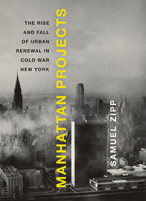The Skyscraper Museum is devoted to the study of high-rise building, past, present, and future. The Museum explores tall buildings as objects of design, products of technology, sites of construction, investments in real estate, and places of work and residence. This site will look better in a browser that supports web standards, but it is accessible to any browser or Internet device.
Sameul Zipp:
MANHATTAN PROJECTS: THE RISE AND FALL OF URBAN RENEWAL IN COLD WAR NEW YORK

Moving beyond the usual good-versus-evil story that pits master-planner Robert Moses against the plucky neighborhood advocate Jane Jacobs, Samuel Zipp sheds new light on the rise and fall of New York's urban renewal in the decades after World War II. Focusing on four iconic "Manhattan projects"--the United Nations building, Stuyvesant Town, Lincoln Center, and the great swaths of public housing in East Harlem--Zipp unearths a host of forgotten stories and characters and shows how boosters hoped to make Manhattan the capital of modernity, while a chorus of critics attacked urban renewal for perpetuating deindustrialization, racial segregation, and class division. Cold War-era urban renewal was not merely a failed planning ideal, Zipp concludes, but also a crucial phase in the transformation of New York into both a world city and one mired in urban crisis.
Samuel Zipp is a cultural, intellectual, and urban historian with particular interest in 20th century cities, the built environment, United States history since World War II. He earned his Ph.D. in American Studies from Yale University. He is an Assistant Professor of American Civilization and Urban Studies at Brown University, teaching courses in 20th century urban and suburban history, politics and culture in New York City since 1945, and popular music and the city.
 Check out the MANHATTAN PROJECTS Facebook page!
Check out the MANHATTAN PROJECTS Facebook page!
Visit our Programs Archive Video Index!
The exhibitions and programs of The Skyscraper Museum are supported by public funds from the New York City Department of Cultural Affairs and the New York State Council on the Arts, a State Agency.



